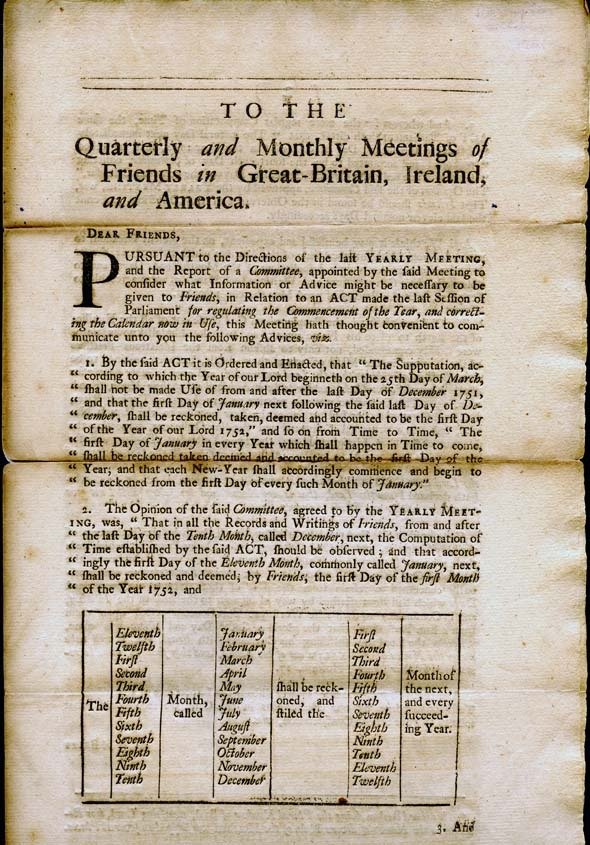The Quaker Calendar

Epistle sent by the London Yearly Meeting for Sufferings in 1751
Calendar Changes
Up to and including 1751 the Julian calendar was used in England, Wales, Ireland, and the British colonies overseas. In these places the year officially began on 25 March. As an example, 24 March 1750 was followed the next day by 25 March 1751. In 1752 the law changed: the year 1751 began on 25 March 1751 and ended on 31 December 1751, to be immediately flowed by 1 January 1752. It is important to note that in Europe and in Scotland the new calendar (the Gregorian) had already superseded the Julian calendar.
Quakers followed the English practice, with one exception. They objected to using those names of days (Sunday to Saturday) and months (January to August) which derived from pagan gods, substituting numbers. Thus Sunday was for them "First Day." Until 1752, they had no problem with the months September to December, which were derived from numbers, but for the other months they wrote out "First Month," "Second Month," and so on. They sometimes used Roman numerals (i-xii) for these, and sometimes Arabic (1-12). After 1752 all months were referred to by Quakers by their number. September became "Ninth Month" and so on.
Today some researchers find it useful to write down the old style numbers as in the original text, but add the new style names in square brackets, such as:
27 iv [June] 1731 or 29 4mo. [June] 1731.
Most computer programs require the use of modern dating. In this case researchers should use the old date, but note them as "o.s." (old style) so that the reader knows that it has not been converted.
Double Dating
January and February present some complications. The English who were aware of the difference between the two calendars often "double-dated" documents by giving both their own and the Gregorian calendar year to avoid confusion, so that 8 11 mo 1732 may appear as 8 11mo February] 1732/3. The first 24 days of March present even greater complications. Often these are double-dated, ie. 21 1mo [March] 1708/9. When they are single-dated, the writer is usually but not always anticipating the year beginning on the 25 March so 8 1mo [March] 1734 is probably 8 1mo [March] 1734/5, but may be 8 1mo [March] 1733/4.
Old-style date converter tool
Need a little help converting from old-style to computer-readable date? If you have a Google account, you can try this handy tool created by FHL staff member James Truitt.
- Click this link to access the Old Style date converter
- You may get a prompt to log into your Google account if you're not already logged in
- You will get a prompt that asks, "Would you like to make a copy of Old Style date converter?" Click the "Make a copy" button
- Enter the old-style date per the instructions on the form, and the new-style date will be generated automatically!
If you have any trouble using the Old Style date converter tool, you may contact friends@swarthmore.edu


